Lecture
Number theory (or arithmetic or higher arithmetic in older usage) is a branch of pure mathematics devoted primarily to the study of the integers and arithmetic functions. German mathematician Carl Friedrich Gauss (1777–1855) said, "Mathematics is the queen of the sciences—and number theory is the queen of mathematics."[1] Number theorists study prime numbers as well as the properties of mathematical objects constructed from integers (for example, rational numbers), or defined as generalizations of the integers (for example, algebraic integers).
Integers can be considered either in themselves or as solutions to equations (Diophantine geometry). Questions in number theory are often best understood through the study of analytical objects (for example, the Riemann zeta function) that encode properties of the integers, primes or other number-theoretic objects in some fashion (analytic number theory). One may also study real numbers in relation to rational numbers; for example, as approximated by the latter (Diophantine approximation).
The older term for number theory is arithmetic. By the early twentieth century, it had been superseded by number theory. (The word arithmetic is used by the general public to mean "elementary calculations"; it has also acquired other meanings in mathematical logic, as in Peano arithmetic, and computer science, as in floating-point arithmetic.) The use of the term arithmetic for number theory regained some ground in the second half of the 20th century, arguably in part due to French influence. In particular, arithmetical is commonly preferred as an adjective to number-theoretic.
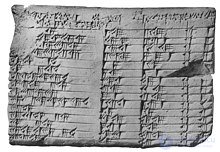
The Plimpton 322 tablet
The earliest historical find of an arithmetical nature is a fragment of a table: the broken clay tablet Plimpton 322 (Larsa, Mesopotamia, ca. 1800 BC) contains a list of "Pythagorean triples", that is, integers such that
. The triples are too many and too large to have been obtained by brute force. The heading over the first column reads: "The takiltum of the diagonal which has been subtracted such that the width..."[2]
The table's layout suggests[3] that it was constructed by means of what amounts, in modern language, to the identity
which is implicit in routine Old Babylonian exercises.[4] If some other method was used,[5] the triples were first constructed and then reordered by , presumably for actual use as a "table", for example, with a view to applications.
It is not known what these applications may have been, or whether there could have been any; Babylonian astronomy, for example, truly came into its own only later. It has been suggested instead that the table was a source of numerical examples for school problems.[6][note 3]
While evidence of Babylonian number theory is only survived by the Plimpton 322 tablet, some authors assert that Babylonian algebra was exceptionally well developed and included the foundations of modern elementary algebra.[7] Late Neoplatonic sources[8] state that Pythagoras learned mathematics from the Babylonians. Much earlier sources[9] state that Thales and Pythagoras traveled and studied in Egypt.
In book nine of Euclid's Elements, propositions 21–34 are very probably influenced by Pythagorean teachings;[10] it is very simple material ("odd times even is even", "if an odd number measures [= divides] an even number, then it also measures [= divides] half of it"), but it is all that is needed to prove that is irrational.[11] Pythagorean mystics gave great importance to the odd and the even.[12] The discovery that
is irrational is credited to the early Pythagoreans (pre-Theodorus).[13] By revealing (in modern terms) that numbers could be irrational, this discovery seems to have provoked the first foundational crisis in mathematical history; its proof or its divulgation are sometimes credited to Hippasus, who was expelled or split from the Pythagorean sect.[14] This forced a distinction between numbers (integers and the rationals—the subjects of arithmetic), on the one hand, and lengths and proportions (which may be identified with real numbers, whether rational or not), on the other hand.
The Pythagorean tradition spoke also of so-called polygonal or figurate numbers.[15] While square numbers, cubic numbers, etc., are seen now as more natural than triangular numbers, pentagonal numbers, etc., the study of the sums of triangular and pentagonal numbers would prove fruitful in the early modern period (17th to early 19th centuries).
The Chinese remainder theorem appears as an exercise[16] in Sunzi Suanjing (3rd, 4th or 5th century CE).[17] (There is one important step glossed over in Sunzi's solution:[note 4] it is the problem that was later solved by Āryabhaṭa's Kuṭṭaka – see below.) The result was later generalized with a complete solution called Da-yan-shu (大衍術) in Qin Jiushao's 1247 Mathematical Treatise in Nine Sections [18] which was translated into English in early 19th century by British missionary Alexander Wylie.[19]
There is also some numerical mysticism in Chinese mathematics,[note 5] but, unlike that of the Pythagoreans, it seems to have led nowhere.
Aside from a few fragments, the mathematics of Classical Greece is known to us either through the reports of contemporary non-mathematicians or through mathematical works from the early Hellenistic period.[20] In the case of number theory, this means, by and large, Plato and Euclid, respectively.
While Asian mathematics influenced Greek and Hellenistic learning, it seems to be the case that Greek mathematics is also an indigenous tradition.
Eusebius, PE X, chapter 4 mentions of Pythagoras:
"In fact the said Pythagoras, while busily studying the wisdom of each nation, visited Babylon, and Egypt, and all Persia, being instructed by the Magi and the priests: and in addition to these he is related to have studied under the Brahmans (these are Indian philosophers); and from some he gathered astrology, from others geometry, and arithmetic and music from others, and different things from different nations, and only from the wise men of Greece did he get nothing, wedded as they were to a poverty and dearth of wisdom: so on the contrary he himself became the author of instruction to the Greeks in the learning which he had procured from abroad."[21]
Aristotle claimed that the philosophy of Plato closely followed the teachings of the Pythagoreans,[22] and Cicero repeats this claim: Platonem ferunt didicisse Pythagorea omnia ("They say Plato learned all things Pythagorean").[23]
Plato had a keen interest in mathematics, and distinguished clearly between arithmetic and calculation. (By arithmetic he meant, in part, theorising on number, rather than what arithmetic or number theory have come to mean.) It is through one of Plato's dialogues—namely, Theaetetus—that it is known that Theodorus had proven that are irrational. Theaetetus was, like Plato, a disciple of Theodorus's; he worked on distinguishing different kinds of incommensurables, and was thus arguably a pioneer in the study of number systems. (Book X of Euclid's Elements is described by Pappus as being largely based on Theaetetus's work.)
Euclid devoted part of his Elements to prime numbers and divisibility, topics that belong unambiguously to number theory and are basic to it (Books VII to IX of Euclid's Elements). In particular, he gave an algorithm for computing the greatest common divisor of two numbers (the Euclidean algorithm; Elements, Prop. VII.2) and the first known proof of the infinitude of primes (Elements, Prop. IX.20).
In 1773, Lessing published an epigram he had found in a manuscript during his work as a librarian; it claimed to be a letter sent by Archimedes to Eratosthenes.[24][25] The epigram proposed what has become known as Archimedes's cattle problem; its solution (absent from the manuscript) requires solving an indeterminate quadratic equation (which reduces to what would later be misnamed Pell's equation). As far as it is known, such equations were first successfully treated by the Indian school. It is not known whether Archimedes himself had a method of solution.
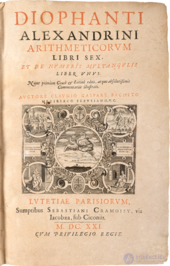
Title page of the 1621 edition of Diophantus of Alexandria's Arithmetica, translated into Latin by Claude Gaspard Bachet de Méziriac
Very little is known about Diophantus of Alexandria; he probably lived in the third century AD, that is, about five hundred years after Euclid. Six out of the thirteen books of Diophantus's Arithmetica survive in the original Greek and four more survive in an Arabic translation. The Arithmetica is a collection of worked-out problems where the task is invariably to find rational solutions to a system of polynomial equations, usually of the form or
. Thus, nowadays, a Diophantine equations a polynomial equations to which rational or integer solutions are sought.
While Greek astronomy probably influenced Indian learning, to the point of introducing trigonometry,[26] it seems to be the case that Indian mathematics is otherwise an indigenous tradition;[27] in particular, there is no evidence that Euclid's Elements reached India before the 18th century.[28]
Āryabhaṭa (476–550 AD) showed that pairs of simultaneous congruences ,
could be solved by a method he called kuṭṭaka, or pulveriser;[29] this is a procedure close to (a generalisation of) the Euclidean algorithm, which was probably discovered independently in India.[30] Āryabhaṭa seems to have had in mind applications to astronomical calculations.[26]
Brahmagupta (628 AD) started the systematic study of indefinite quadratic equations—in particular, the misnamed Pell equation, in which Archimedes may have first been interested, and which did not start to be solved in the West until the time of Fermat and Euler. Later Sanskrit authors would follow, using Brahmagupta's technical terminology. A general procedure (the chakravala, or "cyclic method") for solving Pell's equation was finally found by Jayadeva (cited in the eleventh century; his work is otherwise lost); the earliest surviving exposition appears in Bhāskara II's Bīja-gaṇita (twelfth century).[31]
Indian mathematics remained largely unknown in Europe until the late eighteenth century;[32] Brahmagupta and Bhāskara's work was translated into English in 1817 by Henry Colebrooke.[33]
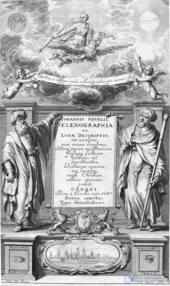
Al-Haytham as seen by the West: on the frontispiece of Selenographia Alhasen [sic] represents knowledge through reason and Galileo knowledge through the senses.
In the early ninth century, the caliph Al-Ma'mun ordered translations of many Greek mathematical works and at least one Sanskrit work (the Sindhind, which may[34] or may not[35] be Brahmagupta's Brāhmasphuṭasiddhānta). Diophantus's main work, the Arithmetica, was translated into Arabic by Qusta ibn Luqa (820–912). Part of the treatise al-Fakhri (by al-Karajī, 953 – ca. 1029) builds on it to some extent. According to Rashed Roshdi, Al-Karajī's contemporary Ibn al-Haytham knew[36] what would later be called Wilson's theorem.
Other than a treatise on squares in arithmetic progression by Fibonacci—who traveled and studied in north Africa and Constantinople—no number theory to speak of was done in western Europe during the Middle Ages. Matters started to change in Europe in the late Renaissance, thanks to a renewed study of the works of Greek antiquity. A catalyst was the textual emendation and translation into Latin of Diophantus' Arithmetica.[37]
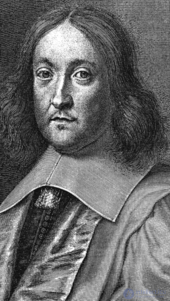
Pierre de Fermat
Pierre de Fermat (1607–1665) never published his writings; in particular, his work on number theory is contained almost entirely in letters to mathematicians and in private marginal notes.[38] In his notes and letters, he scarcely wrote any proofs—he had no models in the area.[39]
Over his lifetime, Fermat made the following contributions to the field:
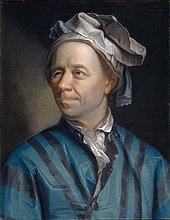
Leonhard Euler
The interest of Leonhard Euler (1707–1783) in number theory was first spurred in 1729, when a friend of his, the amateur[note 8] Goldbach, pointed him towards some of Fermat's work on the subject.[50][51] This has been called the "rebirth" of modern number theory,[52] after Fermat's relative lack of success in getting his contemporaries' attention for the subject.[53] Euler's work on number theory includes the following:[54]

"Here was a problem, that I, a ten-year-old, could understand, and I knew from that moment that I would never let it go. I had to solve it."[65] —Sir Andrew Wiles about his proof of Fermat's Last Theorem.
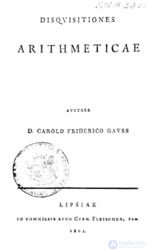
Carl Friedrich Gauss's Disquisitiones Arithmeticae, first edition
Joseph-Louis Lagrange (1736–1813) was the first to give full proofs of some of Fermat's and Euler's work and observations—for instance, the four-square theorem and the basic theory of the misnamed "Pell's equation" (for which an algorithmic solution was found by Fermat and his contemporaries, and also by Jayadeva and Bhaskara II before them.) He also studied quadratic forms in full generality (as opposed to )—defining their equivalence relation, showing how to put them in reduced form, etc.
Adrien-Marie Legendre (1752–1833) was the first to state the law of quadratic reciprocity. He also conjectured what amounts to the prime number theorem and Dirichlet's theorem on arithmetic progressions. He gave a full treatment of the equation [66] and worked on quadratic forms along the lines later developed fully by Gauss.[67] In his old age, he was the first to prove Fermat's Last Theorem for
(completing work by Peter Gustav Lejeune Dirichlet, and crediting both him and Sophie Germain).[68]
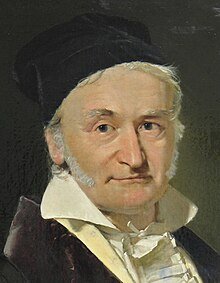
Carl Friedrich Gauss
In his Disquisitiones Arithmeticae (1798), Carl Friedrich Gauss (1777–1855) proved the law of quadratic reciprocity and developed the theory of quadratic forms (in particular, defining their composition). He also introduced some basic notation (congruences) and devoted a section to computational matters, including primality tests.[69] The last section of the Disquisitiones established a link between roots of unity and number theory:
The theory of the division of the circle...which is treated in sec. 7 does not belong by itself to arithmetic, but its principles can only be drawn from higher arithmetic.[70]
In this way, Gauss arguably made a first foray towards both Évariste Galois's work and algebraic number theory.
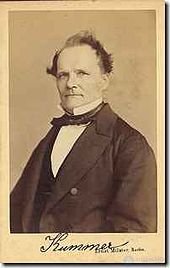
Ernst Kummer
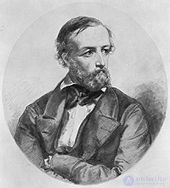
Peter Gustav Lejeune Dirichlet
Starting early in the nineteenth century, the following developments gradually took place:
Algebraic number theory may be said to start with the study of reciprocity and cyclotomy, but truly came into its own with the development of abstract algebra and early ideal theory and valuation theory; see below. A conventional starting point for analytic number theory is Dirichlet's theorem on arithmetic progressions (1837),[72][73] whose proof introduced L-functions and involved some asymptotic analysis and a limiting process on a real variable.[74] The first use of analytic ideas in number theory actually goes back to Euler (1730s),[75][76] who used formal power series and non-rigorous (or implicit) limiting arguments. The use of complex analysis in number theory comes later: the work of Bernhard Riemann (1859) on the zeta function is the canonical starting point;[77] Jacobi's four-square theorem (1839), which predates it, belongs to an initially different strand that has by now taken a leading role in analytic number theory (modular forms).[78]
The history of each subfield is briefly addressed in its own section below; see the main article of each subfield for fuller treatments. Many of the most interesting questions in each area remain open and are being actively worked on.
The term elementary generally denotes a method that does not use complex analysis. For example, the prime number theorem was first proven using complex analysis in 1896, but an elementary proof was found only in 1949 by Erdős and Selberg.[79] The term is somewhat ambiguous: for example, proofs based on complex Tauberian theorems (for example, Wiener–Ikehara) are often seen as quite enlightening but not elementary, in spite of using Fourier analysis, rather than complex analysis as such. Here as elsewhere, an elementary proof may be longer and more difficult for most readers than a non-elementary one.
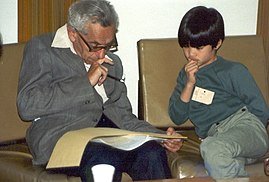
Number theorists Paul Erdős and Terence Tao in 1985, when Erdős was 72 and Tao was 10
Number theory has the reputation of being a field many of whose results can be stated to the layperson. At the same time, the proofs of these results are not particularly accessible, in part because the range of tools they use is, if anything, unusually broad within mathematics.[80]

Riemann zeta function ζ(s) in the complex plane. The color of a point s gives the value of ζ(s): dark colors denote values close to zero and hue gives the value's argument.

The action of the modular group on the upper half plane. The region in grey is the standard fundamental domain.
Analytic number theory may be defined
Some subjects generally considered to be part of analytic number theory, for example, sieve theory,[note 9] are better covered by the second rather than the first definition: some of sieve theory, for instance, uses little analysis,[note 10] yet it does belong to analytic number theory.
The following are examples of problems in analytic number theory: the prime number theorem, the Goldbach conjecture (or the twin prime conjecture, or the Hardy–Littlewood conjectures), the Waring problem and the Riemann hypothesis. Some of the most important tools of analytic number theory are the circle method, sieve methods and L-functions (or, rather, the study of their properties). The theory of modular forms (and, more generally, automorphic forms) also occupies an increasingly central place in the toolbox of analytic number theory.[82]
One may ask analytic questions about algebraic numbers, and use analytic means to answer such questions; it is thus that algebraic and analytic number theory intersect. For example, one may define prime ideals (generalizations of prime numbers in the field of algebraic numbers) and ask how many prime ideals there are up to a certain size. This question can be answered by means of an examination of Dedekind zeta functions, which are generalizations of the Riemann zeta function, a key analytic object at the roots of the subject.[83] This is an example of a general procedure in analytic number theory: deriving information about the distribution of a sequence (here, prime ideals or prime numbers) from the analytic behavior of an appropriately constructed complex-valued function.[84]
An algebraic number is any complex number that is a solution to some polynomial equation with rational coefficients; for example, every solution
of
(say) is an algebraic number. Fields of algebraic numbers are also called algebraic number fields, or shortly number fields. Algebraic number theory studies algebraic number fields.[85] Thus, analytic and algebraic number theory can and do overlap: the former is defined by its methods, the latter by its objects of study.
It could be argued that the simplest kind of number fields (viz., quadratic fields) were already studied by Gauss, as the discussion of quadratic forms in Disquisitiones arithmeticae can be restated in terms of ideals and norms in quadratic fields. (A quadratic field consists of all numbers of the form , where
and
are rational numbers and
is a fixed rational number whose square root is not rational.) For that matter, the 11th-century chakravala method amounts—in modern terms—to an algorithm for finding the units of a real quadratic number field. However, neither Bhāskara nor Gauss knew of number fields as such.
The grounds of the subject were set in the late nineteenth century, when ideal numbers, the theory of ideals and valuation theory were introduced; these are three complementary ways of dealing with the lack of unique factorisation in algebraic number fields. (For example, in the field generated by the rationals and , the number
can be factorised both as
and
; all of
,
,
and
are irreducible, and thus, in a naïve sense, analogous to primes among the integers.) The initial impetus for the development of ideal numbers (by Kummer) seems to have come from the study of higher reciprocity laws,[86] that is, generalisations of quadratic reciprocity.
Number fields are often studied as extensions of smaller number fields: a field L is said to be an extension of a field K if L contains K. (For example, the complex numbers C are an extension of the reals R, and the reals R are an extension of the rationals Q.) Classifying the possible extensions of a given number field is a difficult and partially open problem. Abelian extensions—that is, extensions L of K such that the Galois group[note 11] Gal(L/K) of L over K is an abelian group—are relatively well understood. Their classification was the object of the programme of class field theory, which was initiated in the late 19th century (partly by Kronecker and Eisenstein) and carried out largely in 1900–1950.
An example of an active area of research in algebraic number theory is Iwasawa theory. The Langlands program, one of the main current large-scale research plans in mathematics, is sometimes described as an attempt to generalise class field theory to non-abelian extensions of number fields.
The central problem of Diophantine geometry is to determine when a Diophantine equation has solutions, and if it does, how many. The approach taken is to think of the solutions of an equation as a geometric object.
For example, an equation in two variables defines a curve in the plane. More generally, an equation or system of equations in two or more variables defines a curve, a surface, or some other such object in n-dimensional space. In Diophantine geometry, one asks whether there are any rational points (points all of whose coordinates are rationals) or integral points (points all of whose coordinates are integers) on the curve or surface. If there are any such points, the next step is to ask how many there are and how they are distributed. A basic question in this direction is whether there are finitely or infinitely many rational points on a given curve or surface.
An example here may be helpful. Consider the Pythagorean equation one would like to know its rational solutions; that is, its solutions
such that x and y are both rational. This is the same as asking for all integer solutions to
; any solution to the latter equation gives us a solution
,
to the former. It is also the same as asking for all points with rational coordinates on the curve described by
(a circle of radius 1 centered on the origin).
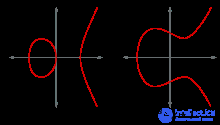
Two examples of elliptic curves, that is, curves of genus 1 having at least one rational point. Such curves have always infinitely many rational points.
The rephrasing of questions on equations in terms of points on curves is felicitous. The finiteness or not of the number of rational or integer points on an algebraic curve (that is, rational or integer solutions to an equation , where
is a polynomial in two variables) depends crucially on the genus of the curve.[note 12] A major achievement of this approach is Wiles's proof of Fermat's Last Theorem, for which other geometrical notions are just as crucial.
There is also the closely linked area of Diophantine approximations: given a number , determine how well it can be approximated by rational numbers. One seeks approximations that are good relative to the amount of space required to write the rational number: call
(with
) a good approximation to
if
, where
is large. This question is of special interest if
is an algebraic number. If
cannot be approximated well, then some equations do not have integer or rational solutions. Moreover, several concepts (especially that of height) are critical both in Diophantine geometry and in the study of Diophantine approximations. This question is also of special interest in transcendental number theory: if a number can be approximated better than any algebraic number, then it is a transcendental number. It is by this argument that π and e have been shown to be transcendental.
Diophantine geometry should not be confused with the geometry of numbers, which is a collection of graphical methods for answering certain questions in algebraic number theory. Arithmetic geometry, however, is a contemporary term for much the same domain as that covered by the term Diophantine geometry. The term arithmetic geometry is arguably used most often when one wishes to emphasize the connections to modern algebraic geometry (for example, in Faltings's theorem) rather than to techniques in Diophantine approximations.
The areas below date from no earlier than the mid-twentieth century, even if they are based on older material. For example, as explained below, algorithms in number theory have a long history, arguably predating the formal concept of proof. However, the modern study of computability began only in the 1930s and 1940s, while computational complexity theory emerged in the 1970s.
Probabilistic number theory starts with questions such as the following ones: Take an integer n at random between one and a million. How likely is it to be prime? (this is just another way of asking how many primes there are between one and a million). How many prime divisors will n have on average? What is the probability that it will have many more or many fewer divisors or prime divisors than the average?
Much of probabilistic number theory can be seen as an important special case of the study of variables that are almost, but not quite, mutually independent. For example, the event that a random integer between one and a million be divisible by two and the event that it be divisible by three are almost independent, but not quite.
It is sometimes said that probabilistic combinatorics uses the fact that whatever happens with probability greater than must happen sometimes; one may say with equal justice that many applications of probabilistic number theory hinge on the fact that whatever is unusual must be rare. If certain algebraic objects (say, rational or integer solutions to certain equations) can be shown to be in the tail of certain sensibly defined distributions, it follows that there must be few of them; this is a very concrete non-probabilistic statement following from a probabilistic one.
At times, a non-rigorous, probabilistic approach leads to a number of heuristic algorithms and open problems, notably Cramér's conjecture.
Arithmetic combinatorics starts with questions like the following ones: Does a fairly "thick" infinite set contain many elements in arithmetic progression:
,
, say? Should it be possible to write large integers as sums of elements of
?
These questions are characteristic of arithmetic combinatorics. This is a presently coalescing field; it subsumes additive number theory (which concerns itself with certain very specific sets of arithmetic significance, such as the primes or the squares) and, arguably, some of the geometry of numbers, together with some rapidly developing new material. Its focus on issues of growth and distribution accounts in part for its developing links with ergodic theory, finite group theory, model theory, and other fields. The term additive combinatorics is also used; however, the sets
being studied need not be sets of integers, but rather subsets of non-commutative groups, for which the multiplication symbol, not the addition symbol, is traditionally used; they can also be subsets of rings, in which case the growth of
and
·
may be compared.
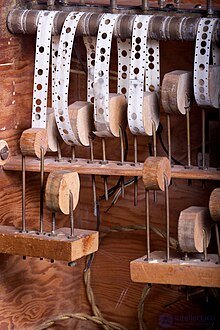
A Lehmer sieve, a primitive digital computer used to find primes and solve simple Diophantine equations
While the word algorithm goes back only to certain readers of al-Khwārizmī, careful descriptions of methods of solution are older than proofs: such methods (that is, algorithms) are as old as any recognisable mathematics—ancient Egyptian, Babylonian, Vedic, Chinese—whereas proofs appeared only with the Greeks of the classical period.
An early case is that of what is now called the Euclidean algorithm. In its basic form (namely, as an algorithm for computing the greatest common divisor) it appears as Proposition 2 of Book VII in Elements, together with a proof of correctness. However, in the form that is often used in number theory (namely, as an algorithm for finding integer solutions to an equation , or, what is the same, for finding the quantities whose existence is assured by the Chinese remainder theorem) it first appears in the works of Āryabhaṭa (5th–6th century CE) as an algorithm called kuṭṭaka ("pulveriser"), without a proof of correctness.
There are two main questions: "Can this be computed?" and "Can it be computed rapidly?" Anyone can test whether a number is prime or, if it is not, split it into prime factors; doing so rapidly is another matter. Fast algorithms for testing primality are now known, but, in spite of much work (both theoretical and practical), no truly fast algorithm for factoring.
The difficulty of a computation can be useful: modern protocols for encrypting messages (for example, RSA) depend on functions that are known to all, but whose inverses are known only to a chosen few, and would take one too long a time to figure out on one's own. For example, these functions can be such that their inverses can be computed only if certain large integers are factorized. While many difficult computational problems outside number theory are known, most working encryption protocols nowadays are based on the difficulty of a few number-theoretical problems.
Some things may not be computable at all; in fact, this can be proven in some instances. For instance, in 1970, it was proven, as a solution to Hilbert's tenth problem, that there is no Turing machine which can solve all Diophantine equations.[87] In particular, this means that, given a computably enumerable set of axioms, there are Diophantine equations for which there is no proof, starting from the axioms, of whether the set of equations has or does not have integer solutions. (i.e., Diophantine equations for which there are no integer solutions, since, given a Diophantine equation with at least one solution, the solution itself provides a proof of the fact that a solution exists. It cannot be proven that a particular Diophantine equation is of this kind, since this would imply that it has no solutions.)
The number-theorist Leonard Dickson (1874–1954) said "Thank God that number theory is unsullied by any application". Such a view is no longer applicable to number theory.[88] In 1974, Donald Knuth said "virtually every theorem in elementary number theory arises in a natural, motivated way in connection with the problem of making computers do high-speed numerical calculations".[89] Elementary number theory is taught in discrete mathematics courses for computer scientists. It also has applications to the continuous in numerical analysis.[90]
Number theory has now several modern applications spanning diverse areas such as:
The American Mathematical Society awards the Cole Prize in Number Theory. Moreover, number theory is one of the three mathematical subdisciplines rewarded by the Fermat Prize.
Large numbers are numbers far larger than those encountered in everyday life, such as simple counting or financial transactions. These quantities appear prominently in mathematics, cosmology, cryptography, and statistical mechanics. Googology studies the naming conventions and properties of these immense numbers.[1][2]
Since the customary decimal format of large numbers can be lengthy, other systems have been devised that allows for shorter representation. For example, a billion is represented as 13 characters (1,000,000,000) in decimal format, but is only 3 characters (109) when expressed in exponential format. A trillion is 17 characters in decimal, but only 4 (1012) in exponential. Values that vary dramatically can be represented and compared graphically via logarithmic scale.
Scientific notation was devised to represent the vast range of values encountered in scientific research in a format that is more compact than traditional formats yet allows for high precision when called for. A value is represented as a decimal fraction times a multiple power of 10. The factor is intended to make reading comprehension easier than a lengthy series of zeros. For example, 1.0×109 expresses one billion – 1 followed by nine zeros. The reciprocal, one billionth, is 1.0×10−9. Sometimes the letter e replaces the exponent, for example 1 billion may be expressed as 1e9 instead of 1.0×109.
Examples of large numbers describing real-world things:
In astronomy and cosmology large numbers for measures of length and time are encountered. For instance, according to the prevailing Big Bang model, the universe is approximately 13.8 billion years old (equivalent to 4.355×1017 seconds). The observable universe spans 93 billion light years (approximately 8.8×1026 meters) and hosts around 5×1022 stars, organized into roughly 125 billion galaxies (as observed by the Hubble Space Telescope). As a rough estimate, there are about 1080 atoms within the observable universe.[8]
According to Don Page, physicist at the University of Alberta, Canada, the longest finite time that has so far been explicitly calculated by any physicist is
10101010101.1 years
(which corresponds to the scale of an estimated Poincaré recurrence time for the quantum state of a hypothetical box containing a black hole with the estimated mass of the entire universe, observable or not, assuming a certain inflationary model with an inflaton whose mass is 10−6 Planck masses), roughly 10^10^1.288*10^3.884 T [9][10] This time assumes a statistical model subject to Poincaré recurrence. A much simplified way of thinking about this time is in a model where the universe's history repeats itself arbitrarily many times due to properties of statistical mechanics; this is the time scale when it will first be somewhat similar (for a reasonable choice of "similar") to its current state again.
Combinatorial processes give rise to astonishingly large numbers. The factorial function, which quantifies permutations of a fixed set of objects, grows superexponentially as the number of objects increases. Stirling's formula provides a precise asymptotic expression for this rapid growth.
In statistical mechanics, combinatorial numbers reach such immense magnitudes that they are often expressed using logarithms.
Gödel numbers, along with similar representations of bit-strings in algorithmic information theory, are vast—even for mathematical statements of moderate length. Remarkably, certain pathological numbers surpass even the Gödel numbers associated with typical mathematical propositions.
Logician Harvey Friedman has made significant contributions to the study of very large numbers, including work related to Kruskal's tree theorem and the Robertson–Seymour theorem.
To help viewers of Cosmos distinguish between "millions" and "billions", astronomer Carl Sagan stressed the "b". Sagan never did, however, say "billions and billions". The public's association of the phrase and Sagan came from a Tonight Show skit. Parodying Sagan's effect, Johnny Carson quipped "billions and billions".[11] The phrase has, however, now become a humorous fictitious number—the Sagan. Cf., Sagan Unit.
A standardized way of writing very large numbers allows them to be easily sorted in increasing order, and one can get a good idea of how much larger a number is than another one.
To compare numbers in scientific notation, say 5×104 and 2×105, compare the exponents first, in this case 5 > 4, so 2×105 > 5×104. If the exponents are equal, the mantissa (or coefficient) should be compared, thus 5×104 > 2×104 because 5 > 2.
Tetration with base 10 gives the sequence 10↑↑n=10→n→2=(10↑)n1, the power towers of numbers 10, where (10↑)n
denotes a functional power of the function f(n)=10n
(the function also expressed by the suffix "-plex" as in googolplex, see the googol family).
These are very round numbers, each representing an order of magnitude in a generalized sense. A crude way of specifying how large a number is, is specifying between which two numbers in this sequence it is.
More precisely, numbers in between can be expressed in the form (10↑)na, i.e., with a power tower of 10s, and a number at the top, possibly in scientific notation, e.g. 10101010104.829=(10↑)54.829
, a number between 10↑↑5
and 10↑↑6
(note that 10↑↑n<(10↑)na<10↑↑(n+1)
if 1<a<10
). (See also extension of tetration to real heights.)
Thus googolplex is 1 .
Another example:
(between 10↑↑65,533
and 10↑↑65,534
)
Thus the "order of magnitude" of a number (on a larger scale than usually meant), can be characterized by the number of times (n) one has to take the log10 to get a number between 1 and 10. Thus, the number is between 10↑↑n
and 10↑↑(n+1)
. As explained, a more precise description of a number also specifies the value of this number between 1 and 10, or the previous number (taking the logarithm one time less) between 10 and 1010, or the next, between 0 and 1.
Note that
10(10↑)nx=(10↑)n10x
I.e., if a number x is too large for a representation (10↑)nx the power tower can be made one higher, replacing x by log10x, or find x from the lower-tower representation of the log10 of the whole number. If the power tower would contain one or more numbers different from 10, the two approaches would lead to different results, corresponding to the fact that extending the power tower with a 10 at the bottom is then not the same as extending it with a 10 at the top (but, of course, similar remarks apply if the whole power tower consists of copies of the same number, different from 10).
If the height of the tower is large, the various representations for large numbers can be applied to the height itself. If the height is given only approximately, giving a value at the top does not make sense, so the double-arrow notation (e.g. 10↑↑(7.21×108)) can be used. If the value after the double arrow is a very large number itself, the above can recursively be applied to that value.
Examples:
(between 10↑↑↑2
and 10↑↑↑3
)
(between 10↑↑↑4
and 10↑↑↑5
)
Similarly to the above, if the exponent of (10↑) is not exactly given then giving a value at the right does not make sense, and instead of using the power notation of (10↑)
, it is possible to add 1
to the exponent of (10↑↑)
, to obtain e.g. (10↑↑)3(2.8×1012)
.
If the exponent of (10↑↑) is large, the various representations for large numbers can be applied to this exponent itself. If this exponent is not exactly given then, again, giving a value at the right does not make sense, and instead of using the power notation of (10↑↑)
it is possible use the triple arrow operator, e.g. 10↑↑↑(7.3×106)
.
If the right-hand argument of the triple arrow operator is large the above applies to it, obtaining e.g. 10↑↑↑(10↑↑)2(10↑)497(9.73×1032) (between 10↑↑↑10↑↑↑4
and 10↑↑↑10↑↑↑5
). This can be done recursively, so it is possible to have a power of the triple arrow operator.
Then it is possible to proceed with operators with higher numbers of arrows, written ↑n.
Compare this notation with the hyper operator and the Conway chained arrow notation:
a↑nb = ( a → b → n ) = hyper(a, n + 2, b)
An advantage of the first is that when considered as function of b, there is a natural notation for powers of this function (just like when writing out the n arrows): (a↑n)kb. For example:
(10↑2)3b = ( 10 → ( 10 → ( 10 → b → 2 ) → 2 ) → 2 )
and only in special cases the long nested chain notation is reduced; for ″b″=1 obtains:
10↑33=(10↑2)31 = ( 10 → 3 → 3 )
Since the b can also be very large, in general it can be written instead a number with a sequence of powers (10↑n)kn with decreasing values of n (with exactly given integer exponents kn
) with at the end a number in ordinary scientific notation. Whenever a kn
is too large to be given exactly, the value of kn+1
is increased by 1 and everything to the right of (n+1)kn+1
is rewritten.
For describing numbers approximately, deviations from the decreasing order of values of n are not needed. For example, 10↑(10↑↑)5a=(10↑↑)6a, and 10↑(10↑↑↑3)=10↑↑(10↑↑10+1)≈10↑↑↑3
. Thus is obtained the somewhat counterintuitive result that a number x can be so large that, in a way, x and 10x are "almost equal" (for arithmetic of large numbers see also below).
If the superscript of the upward arrow is large, the various representations for large numbers can be applied to this superscript itself. If this superscript is not exactly given then there is no point in raising the operator to a particular power or to adjust the value on which it act, instead it is possible to simply use a standard value at the right, say 10, and the expression reduces to 10↑n10=(10→10→n) with an approximate n. For such numbers the advantage of using the upward arrow notation no longer applies, so the chain notation can be used instead.
The above can be applied recursively for this n, so the notation ↑n is obtained in the superscript of the first arrow, etc., or a nested chain notation, e.g.:
(10 → 10 → (10 → 10 → 3×105) ) = 10↑10↑3×1051010
If the number of levels gets too large to be convenient, a notation is used where this number of levels is written down as a number (like using the superscript of the arrow instead of writing many arrows). Introducing a function f(n)=10↑n10 = (10 → 10 → n), these levels become functional powers of f, allowing us to write a number in the form fm(n)
where m is given exactly and n is an integer which may or may not be given exactly (for example: f2(3×105)
). If n is large, any of the above can be used for expressing it. The "roundest" of these numbers are those of the form fm(1) = (10→10→m→2). For example, (10→10→3→2)=10↑10↑10101010
Compare the definition of Graham's number: it uses numbers 3 instead of 10 and has 64 arrow levels and the number 4 at the top; thus G<3→3→65→2<(10→10→65→2)=f65(1), but also G<f64(4)<f65(1)
.
If m in fm(n) is too large to give exactly, it is possible to use a fixed n, e.g. n = 1, and apply the above recursively to m, i.e., the number of levels of upward arrows is itself represented in the superscripted upward-arrow notation, etc. Using the functional power notation of f this gives multiple levels of f. Introducing a function g(n)=fn(1)
these levels become functional powers of g, allowing us to write a number in the form gm(n)
where m is given exactly and n is an integer which may or may not be given exactly. For example, if (10→10→m→3) = gm(1). If n is large any of the above can be used for expressing it. Similarly a function h, etc. can be introduced. If many such functions are required, they can be numbered instead of using a new letter every time, e.g. as a subscript, such that there are numbers of the form fkm(n)
where k and m are given exactly and n is an integer which may or may not be given exactly. Using k=1 for the f above, k=2 for g, etc., obtains (10→10→n→k) = fk(n)=fk−1n(1)
. If n is large any of the above can be used to express it. Thus is obtained a nesting of forms fkmk
where going inward the k decreases, and with as inner argument a sequence of powers (10↑n)pn
with decreasing values of n (where all these numbers are exactly given integers) with at the end a number in ordinary scientific notation.
When k is too large to be given exactly, the number concerned can be expressed as fn(10)=(10→10→10→n) with an approximate n. Note that the process of going from the sequence 10n
=(10→n) to the sequence 10↑n10
=(10→10→n) is very similar to going from the latter to the sequence fn(10)
=(10→10→10→n): it is the general process of adding an element 10 to the chain in the chain notation; this process can be repeated again (see also the previous section). Numbering the subsequent versions of this function a number can be described using functions fqkmqk
, nested in lexicographical order with q the most significant number, but with decreasing order for q and for k; as inner argument yields a sequence of powers (10↑n)pn
with decreasing values of n (where all these numbers are exactly given integers) with at the end a number in ordinary scientific notation.
For a number too large to write down in the Conway chained arrow notation it size can be described by the length of that chain, for example only using elements 10 in the chain; in other words, one could specify its position in the sequence 10, 10→10, 10→10→10, .. If even the position in the sequence is a large number same techniques can be applied again.
Numbers expressible in decimal notation:
Numbers expressible in scientific notation:
Numbers expressible in (10 ↑)n k notation:
Bigger numbers:
Some notations for extremely large numbers:
These notations are essentially functions of integer variables, which increase very rapidly with those integers. Ever-faster-increasing functions can easily be constructed recursively by applying these functions with large integers as argument.
A function with a vertical asymptote is not helpful in defining a very large number, although the function increases very rapidly: one has to define an argument very close to the asymptote, i.e. use a very small number, and constructing that is equivalent to constructing a very large number, e.g. the reciprocal.
The following illustrates the effect of a base different from 10, base 100. It also illustrates representations of numbers and the arithmetic.
10012=1024, with base 10 the exponent is doubled.
10010012=102∗1024, ditto.
10010010012≈10102∗1024+0.30103, the highest exponent is very little more than doubled (increased by log102).
For a number , one unit change in n changes the result by a factor 10. In a number like
, with the 6.2 the result of proper rounding using significant figures, the true value of the exponent may be 50 less or 50 more. Hence the result may be a factor
too large or too small. This seems like extremely poor accuracy, but for such a large number it may be considered fair (a large error in a large number may be "relatively small" and therefore acceptable).
In the case of an approximation of an extremely large number, the relative error may be large, yet there may still be a sense in which one wants to consider the numbers as "close in magnitude". For example, consider
and
The relative error is
a large relative error. However, one can also consider the relative error in the logarithms; in this case, the logarithms (to base 10) are 10 and 9, so the relative error in the logarithms is only 10%.
The point is that exponential functions magnify relative errors greatly – if a and b have a small relative error,
and
the relative error is larger, and
and
will have an even larger relative error. The question then becomes: on which level of iterated logarithms to compare two numbers? There is a sense in which one may want to consider
and
to be "close in magnitude". The relative error between these two numbers is large, and the relative error between their logarithms is still large; however, the relative error in their second-iterated logarithms is small:
and
Such comparisons of iterated logarithms are common, e.g., in analytic number theory.
One solution to the problem of comparing large numbers is to define classes of numbers, such as the system devised by Robert Munafo,[14] which is based on different "levels" of perception of an average person. Class 0 – numbers between zero and six – is defined to contain numbers that are easily subitized, that is, numbers that show up very frequently in daily life and are almost instantly comparable. Class 1 – numbers between six and 1,000,000=106 – is defined to contain numbers whose decimal expressions are easily subitized, that is, numbers who are easily comparable not by cardinality, but "at a glance" given the decimal expansion.
Each class after these are defined in terms of iterating this base-10 exponentiation, to simulate the effect of another "iteration" of human indistinguishability. For example, class 5 is defined to include numbers between 101010106 and 10101010106, which are numbers where X becomes humanly indistinguishable from X2 [15] (taking iterated logarithms of such X yields indistinguishibility firstly between log(X) and 2log(X), secondly between log(log(X)) and 1+log(log(X)), and finally an extremely long decimal expansion whose length can't be subitized).
There are some general rules relating to the usual arithmetic operations performed on very large numbers:
Hence:
Given a strictly increasing integer sequence/function f0(n) (n≥1), it is possible to produce a faster-growing sequence f1(n)=f0n(n)
(where the superscript n denotes the nth functional power). This can be repeated any number of times by letting fk(n)=fk−1n(n)
, each sequence growing much faster than the one before it. Thus it is possible to define fω(n)=fn(n)
, which grows much faster than any fk
for finite k (here ω is the first infinite ordinal number, representing the limit of all finite numbers k). This is the basis for the fast-growing hierarchy of functions, in which the indexing subscript is extended to ever-larger ordinals.
For example, starting with f0(n) = n + 1:
The busy beaver function Σ is an example of a function which grows faster than any computable function. Its value for even relatively small input is huge. The values of Σ(n) for n = 1, 2, 3, 4, 5 are 1, 4, 6, 13, 4098 (sequence A028444 in the OEIS). Σ(6) is not known but is at least 10↑↑15.
Although all the numbers discussed above are very large, they are all still finite. Certain fields of mathematics define infinite and transfinite numbers. For example, aleph-null is the cardinality of the infinite set of natural numbers, and aleph-one is the next greatest cardinal number. c is the cardinality of the reals. The proposition that
is known as the continuum hypothesis.
Comments
To leave a comment
Arithmetic
Terms: Arithmetic